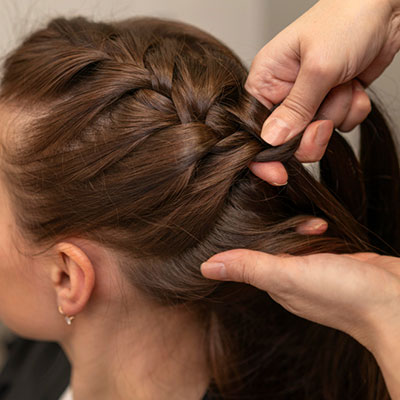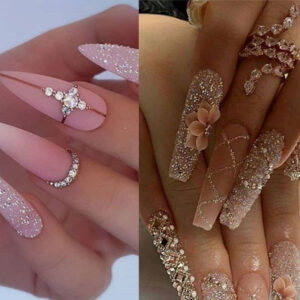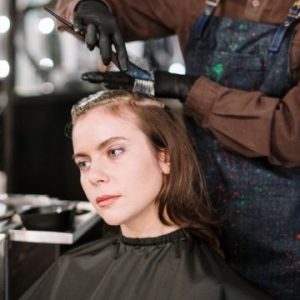An industrial piercing, also known as a scaffold piercing, is a unique type of body piercing that involves two piercings connected with a single piece of jewelry. This piercing typically goes through the upper cartilage of the ear, creating an edgy and eye-catching look.
With its distinctive appearance, an industrial piercing has become a popular choice for those seeking a bold and expressive body modification. It allows individuals to showcase their individuality and personal style, making it a favorite among fashion-forward individuals.
Industrial piercings are making a comeback alongside the resurgence of 1990s fashion and trends. From chunky knits to artfully teased hair, the 90s are having a moment, and industrial piercings are right there with them. While there are plenty of ways to modify your body, such as cartilage piercings or the popular belly button rings loved by Gen Z, few make as bold of a statement as the industrial piercing.
Consider getting an Industrial Piercing – a trend that gained popularity in the early 1990s. With its enduring appeal, there’s no better time than the present to embrace this edgy style.
Style historians attribute the rise of industrial piercings in the ’90s to body piercing artist Erik Dakota. It is said that Dakota showcased various piercing styles in his writings for Body Play magazine, establishing the industrial piercing as a favored trend among piercing enthusiasts. During the 1990s, following the punk or goth era, there was a surge in fads that encouraged individuals to adorn their ears with multiple piercings for a distinct aesthetic.
You may love to watch this video on Industrial Piercing –
When it comes to fashion, there are no definitive rules on what looks are right or wrong. In fact, anyone with the confidence to rock a barbell earring and a resilient cartilage can pull off an industrial piercing. However, if you’re unsure about whether an industrial piercing is the right choice for you, we’re here to provide you with all the essential information you need to know before committing to this striking accessory.
Types of Industrial Piercings
Most industrial piercings typically involve the standard barbell from the forward-helix to the outer-helix. However, what sets them apart is the direction of the piercing.
Industrial piercings offer versatility in terms of placement. One option is a vertical piercing that runs from the top of the helix down through the rook. Alternatively, a piercing can be done from the backside of the upper conch through the lower conch, exiting at the back of the ear. The feasibility of these piercings depends on the individual’s anatomy, making the options unique for each client.
You may love to know about Oral Piercings and Facial Piercings in detail.
What is the Cost of an Industrial Piercing?
An industrial piercing typically consists of two piercings, making it a unique and stylish choice. The cost of this piercing can range between $60 to $80, depending on factors such as the location where you choose to get it done and the type of jewelry you select.
What is the process of industrial piercing?
Getting an industrial piercing is similar to piercing any other part of your ear. The process involves using a hollow needle, but the main distinction is that the needle passes through multiple points in a straight line before the jewelry is inserted. However, it’s important to note that each industrial piercing is unique, as the piercer’s preferences and individual anatomy may require different techniques to be used.
How Long Does It Take For an Industrial Piercing to Heal?
An industrial piercing typically requires six months to a year for complete healing. However, around the three-month mark, it reaches a stage where you can safely change your jewelry.
In the healing phase of getting an industrial piercing, it is important to keep a few best practices in mind. Firstly, it is recommended to avoid sleeping on the side where your new piercing is located until it is fully healed. The same applies to talking on the phone – minimizing pressure on the ear with the piercing is crucial. Additionally, it is essential to be cautious about your haircare and skincare products, as well as their ingredients. If any of these irritate your piercing, it is advisable to find suitable alternatives temporarily. Lastly, when removing your clothes, take care to be gentle around the piercing area. Rough treatment, such as brushing over it with a sweater, can significantly prolong the healing process.
If you are a fan of tattoo then this article about tattoo peeling will be very useful for you.
Is Industrial Piercing Painful?
Pain is a subjective experience, varying from person to person based on their individual pain tolerance. When it comes to cartilage piercings, an industrial piercing is generally considered to be more painful compared to other types. This is due to its larger gauge and the fact that it involves multiple points being pierced simultaneously. However, it’s important to note that the difference in pain level is relatively small, rather than extreme. If you hire a professional to do the piercings and take proper precautions and care the pain can be greatly minimized.
How to Clean Your Industrial Piercing?
To properly care for your industrial piercing, it is important to clean it twice a day, just like any other cartilage piercing. However, it requires diligent and careful cleaning. Use a gentle saline wound wash or a Piercing Aftercare Spray. Maintain this cleaning routine for a minimum of three to six months. Once the initial healing period is over, you can reduce the frequency to once a day.
Meanwhile are you aware of this new fashion trend among the youth called eyebrow slit?
Which Jewelry Materials are the Best for Industrial Piercing?
When selecting jewelry for your industrial piercing, it is important to prioritize implant-grade titanium and 14k gold. These materials are known for their inert properties, meaning they stay in place, and high alloy percentage, ensuring they are not mixed with other substances. Additionally, they are free of nickel and other harmful metals. It is advisable to steer clear of plastics, low purity gold, non-surgical steel, and other low-quality metals. These materials can lead to various issues such as infection, delayed healing, or even hinder the healing process altogether. Even if your piercing is fully healed, using such jewelry may trigger allergic reactions.
Hope you found this piece of information useful and informative. If you really liked this article then please share it on social media and give your feedback in the comments section below.


















I recently got Industrial piercing done but the person who did it on my body was not skilled enough. It was a very painful experience for me. He did not tell me the aftercare instructions. So I am searching it online. Your article is really helpful and I got to know many new things about industrial piercing from here. I have a question if you can answer – Can I take a shower with my industrial piercing?
Thank you!
Hi Mike, Yes, taking a shower after getting a piercing is absolutely fine. However, it is important to protect the wounds by covering them with a material like polythene. You can continue to shower and wash your hair without any worries while your piercing is healing. If the chemicals in your shampoo are causing irritation, consider using a natural alternative. There are many herbal and organic shampoo available in the market.
Very nice article. I got a lot of information about piercing that I wanted to know. But I also wanted to know what is the most painful piercing?
Hi Miranda, as I have already stated in the article, the most painful piercing depends on various factors, such as individual pain tolerance, piercing location, and the expertise of the piercer. Some people argue that certain piercings, like genital or nipple piercings, can be especially excruciating. Other piercing types such as Dermal piercing and Belly button piercing can also be counted as painful ones. However, it is important to remember that pain is subjective, and what may be unbearable for one person may be tolerable for another.
Good article. But I wanted to know which side is better for industrial piercing? Can you please help?
Consider getting an industrial piercing on the side of your face that you don’t sleep on regularly. This can help prevent accidentally pressing on the healing wounds during sleep, which may prolong the healing process. To avoid any inconvenience, it is advisable to let one side of your face heal completely before getting the piercing done on the other side.
Your blog is easy to use. It loads quickly, is simple to navigate, and looks good on my phone or computer. It’s clear you care about the reader’s experience.
The use of personal anecdotes and stories adds a personal touch to your blog. It helps readers connect with the content on a deeper level and makes it more relatable.